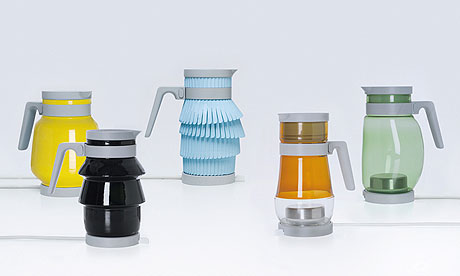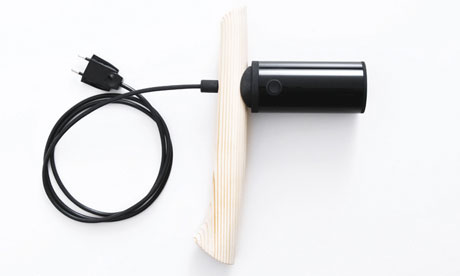In a post-industrial
culture that romanticises the handmade, designers are being called upon
to do something they haven't for a century – make stuff themselves
Flicking through the latest issue of Port, a new "thinking man's" magazine, I came across a photograph of a kind that is increasingly ubiquitous. In an article about two young design practices, there's a picture of a box containing a hammer, some leather-working tools and other bits and bobs of workshop flotsam. With the same pinpoint focus that a food photographer might train at a boeuf bourguignon, the image fetishises its subject – in this case not French cuisine but craftsmanship.
It seems no magazine about material culture, from Monocle to Inventory, is complete these days without a behind-the-scenes story on a little-known clothing or furniture brand featuring people in leather aprons and workbenches strewn with chisels and offcuts. There's nothing new about the kind of products these studios create. What's new is the desire to reveal the process and not just the finished object. These are not-so-subtle messages reasserting the value of the handmade over the machine-made.
On one level, this is just fashion. When Levi's launches a marketing campaign called Levi's Craftwork to sell one of the most mass-produced items of clothing in the world, we can collectively roll our eyes. But I wonder if there's something more profound going on.
In his 2008 book The Craftsman, the sociologist Richard Sennett makes a case for homo faber (or "man as maker"). Harking back to the workshops of the medieval guilds and to the studio of violin-maker Antonio Stradivari, Sennett set out to prove Immanuel Kant's dictum that "the hand is the window on to the mind". It is only through making things, he says – by trying and failing and repeating – that we gain true understanding. He is not, like some latter-day John Ruskin, arguing that handmade things are better than machine-made ones. He is simply saying that skilled manual labour – or indeed any craft – is one path to a fulfilling life.
Blow by blow ... Jean-Baptiste Fastrez's wooden-handled hairdryers appeal to a growing taste for customisation. Photograph: Felipe Ribon
Sennett's idea of a "craftsman" is highly inclusive, but, at least since the industrial revolution, the designer and the craftsman are traditionally different roles. In the world of the Fordist production line, the designer created the templates that industrial craftsmen would replicate in the hundreds or thousands. The conspicuous consumption that defined the second half of the 20th century was driven by mass production; by men (though not always men) in charge of machines. And what Karl Marx called "commodity fetishism" – that ineffable something that gives an object a perceived value greater than its actual material cost – is best exemplified by machinic perfection: the sheen on an iPad, the techno-treads of a Nike trainer. But it seems that increasingly we are swapping one fetish for another.
There is craft fetishism aplenty at an exhibition of work by young designers currently showing at the Villa Noailles near Toulon. The villa, which was built by an art collector couple in the 20s and became a productive playground of sorts for surrealists from Max Ernst to Alberto Giacometti, has a long tradition of patronage. Now it hosts annual exhibitions of work by young designers, and this year's was typical of the direction that graduates' work has been taking in recent years. Almost all the designers seemed concerned to introduce a craft dimension to what would ordinarily be industrial objects. Jean-Baptiste Fastrez created a series of hairdryers with a range of distinctive wooden handles. Is it so frustrating knowing that all those plastic handles are the same, or is the hairdryer-cum-tomahawk simply more manly?
Fastrez is not against industrial production. Indeed, you can't make the working end of a hairdryer or a kettle without it. But his designs for kettles come with a set of standardised plastic and electric parts, while the bodies can be chosen from a series of hand-blown Pyrex or hand-shaped ceramic vessels. Like many designers of his generation, Fastrez is rejecting the one-size-fits-all outcome of traditional manufacturing. In his case, he is appealing to a growing taste for customisation – one that new production technologies are making ever more realistic.
Others in the show, however, have more primitive aims in mind. Icelandic designer Brynjar Sigurdarson created a torch with a long wooden handle, like a broomstick or spear. As many of our modern-day accoutrements – watches, calculators, diaries, newspapers and even torches – converge into a single device, the phone, it's as though Sigurdarson wants to rediscover the atavistic quality of this product, a tool for the hunter-gatherer within.
A number of the designers expressed how important they felt it was to make things with their own hands. This is partly an ethos – much like the slow food movement – but it is also a necessity. Who else is going to make their work? The rise of the designer-maker has a lot to do with the fact that while design is an ever more popular career choice, the opportunities to work with manufacturers are not growing at the same pace (and in the UK are actually diminishing). Where product and furniture designers once aspired to get their work mass-manufactured, many have now given up on the idea. Before the recession, a phantom career path seemed to open up, where a select few designers could sell their work in galleries. Once that bubble had burst, the market replaced the notion of the designer as artist with a humbler proposition, the designer as craftsman.
The problem with craft, of course is that it's expensive. In the 70s the Italian designer Enzo Mari was so disgusted by the quality of affordable furniture available to the public that he created a set of designs which people could make for themselves with a few pine planks, a hammer and some nails. He distributed his Autoprogettazione designs for free to anyone who would send him a stamped envelope. He had more than 5,000 requests. If you wanted to build yourself an Enzo Mari wardrobe today, however, the cost of materials alone would set you back more than a wardrobe from Ikea. And if you paid a craftsman to build it for you, you'd be looking at about four times the cost. This is how much global economics prohibits the idea of accessible craftsmanship, at least in the developed world.
There's no real question of returning to a craft-based economy (or only in the darkest fantasies of a global economic meltdown). What we have here is a post-industrial nostalgia for the pre-industrial. In a culture with a surfeit of branding and cheap mass-produced goods, we romanticise the handmade because we yearn for quality, not quantity. The irony is that while western consumers aspire to craftsmanship, the majority of the world's population lives in countries that have local craftsmen but aspire to industrialised products. Mass manufacturing will be essential to lifting a billion people out of poverty, and providing basic goods that we took for granted long ago. Meanwhile, we'll be seeing more crafted industrial objects coming our way, as we lust after craftsmanship we can't afford and disdain the industrial products we can.
Link to original article



No comments:
Post a Comment